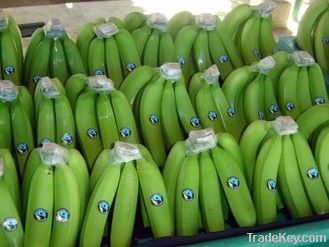Product Description
Variety:Cavendish banana
Class: "A" Premium
Size of the banana (fingers): minimum *0 cm
Diameter: Min. *9 mm Max. *6 mm
Number of bananas per cluster (hand): Minimum of 5, going
up to *2
Age of the fruit: Min: *0 weeks Max. *2 weeks
Boxes: *2XU, weight *0 lbs
**0 boxes on *0 pallets, *8 boxes each
Description:The Cavendish banana is the most widely
consumed banana worldwide. It is of Vietnamese and Chinese
origin. It is usually between *5 and *5 cm long. The
skin is green when sold to markets and later yellow when
ripe. During the ripening process sugars and the
characteristic banana aromas are produced.
Uses: Principally eaten raw, in fruit salads, baby foods,
as well as in different processed foods. This variety is also
used as a dessert.
Storage:Once bought, it is preferable not to store in the
refrigerator because they lose flavour. Once peeled, they should
be eaten immediately because they will spoil very quickly.
To speed up the banana’s ripening, you can put it into a tightly
closed plastic bag and place it somewhere warmer, like on top of
the refrigerator.
If you wish you can freeze your Cavendish bananas. You
should peel them and place them in plastic bags. Bananas
can be preserved frozen for up to six months.
Post-
harvesting
In the cultivation of the BANANA, we follow the rigorous
procedures recommended to achieve the best quality fruit. That
includes the following steps:
- Diameter of the fruit: measurement of the thickness of the
fruit according to the required specifications of the client and
to determine the physiological state of the fruit.
- Harvesting: the cutting of the stalk is done at the
recommended height of the psuedostem and the cut is made
horizontally to reduce the spillage of latex.
- Moving: the moving of the stalks is done by qualified
personnel trained in preserving the quality of the fruit.
- Selection: the fruit is classified depending on the various
categories of quality; the bananas are selected in accordance
with the ranges of quality as specified by each client.
- Deflowering: the flowers are picked off the ends of the
bananas, starting from the bottom and moving upwards to reduce
the possibility of latex.
- Cutting: the clusters are removed from the stalk taking care
not to damage the stems of the bananas, and damaged bananas are
removed.
- Washing: the washing time is approximately *5 to *8 minutes,
with an abundant flow of water to eliminate the latex.
- Fumigation: fumigation is done to principally avoid an
anthracnose attack which lessens the quality of the fruit.
- Drying: drying is done to prevent spoilage and to heal the
cuts on the stems.
- Weight and stickering: bananas are weighed and placed on
trays until they have been filled with the required weight. Then
they are stickered.
- Packing: a plastic bag is placed in a banana box and a heavy
paper division is placed in the bag. Then the bananas are packed
following a low packing pattern, meaning that over-crowding is
avoided. Lastly, the existing air is sucked out of the bag of
bananas and the top of the bag is rubber banded shut.
- Transport: the banana boxes are put on to pallets: this makes
storage and moving easier.
- Port verification: before loading onto the shipping vessel a
last verification of the product is done taking into account the
requirements of each client.
- Why is the Ecuadorian banana rated the best quality banana
and the most environmentally friendly? Banana cultivation requires special climate
and soil characteristics, among those being:
- An average temperature of *5° C (*7° F).
- Regular monthly precipitation between **0 to **0 mm.
- Light is important to guarantee photosynthetic activity in
the plant.
- Winds that do not exceed *0 km per hour.
- Flat and fertile terrain with good drainage, and a pH of
between 6 and 6.5
Ecuador is a privileged country as far as these conditions
go. Average temperatures are inferior to those of the
Caribbean and there is a relatively dry season. This
relates to a lesser occurrence of plagues: the number of
necessary fumigations to maintain the quality of the fruit for
exportation is substantially fewer (*5 to *0 times per year)
compared with other banana cultivating regions like Central
America and the Caribbean which require up to *0 fumigations
annually. Ecuador has an optimum amount of daylight due
to its location in the middle of the world. Ecuador does
not suffer from natural phenomenon like hurricanes, tropical
cyclones/typhoons, or strong/damaging winds.
The banana plantations are located in tropical/humid regions
with flat and fertile terrain. The ground where the
banana is planted is of excellent texture, and among other
qualities very permeable soil which practically eliminates the
possibility of soil erosion. In contrast to other
countries, Ecuador does not need an elevated application of
fertilizers which means that the Ecuadorian banana plantations
have a minimal impact on the environment. Finally,
Ecuador has regulations and permanent controls in place with
regards to labour laws governing banana producers and
workers.
All of these conditions contribute to the Ecuadorian banana
being recognized for its quality, taste, and preferred by the
most demanding markets of Europe, Asia and North America.
This is why Ecuador is the #1 exporter of bananas
worldwide.
-
| Country: |
Ecuador |
| Model No: |
boxes 18.14 Kg
|
| FOB Price: |
8 / Box ( Negotiable ) (Negotiable)
Get Latest Price
|
| Place of Origin: |
- |
| Price for Minimum Order: |
8 per Box |
| Minimum Order Quantity: |
100 Box |
| Packaging Detail: |
Boxes of quality |
| Delivery Time: |
7 days |
| Supplying Ability: |
10 Box per Week |
| Payment Type: |
T/T |
| Product Group : |
product fresh
|


